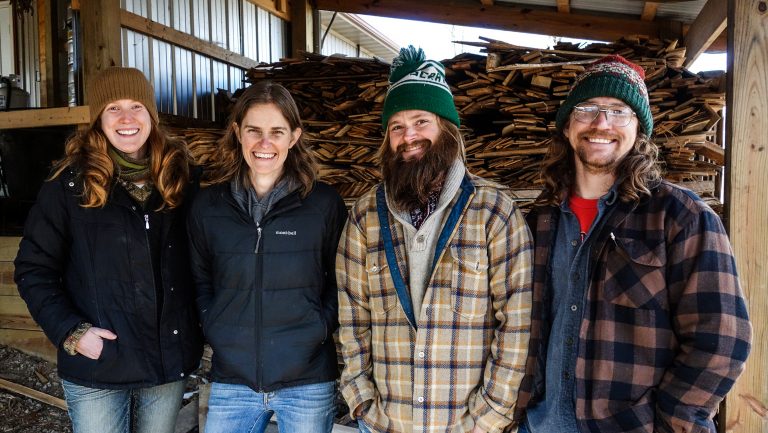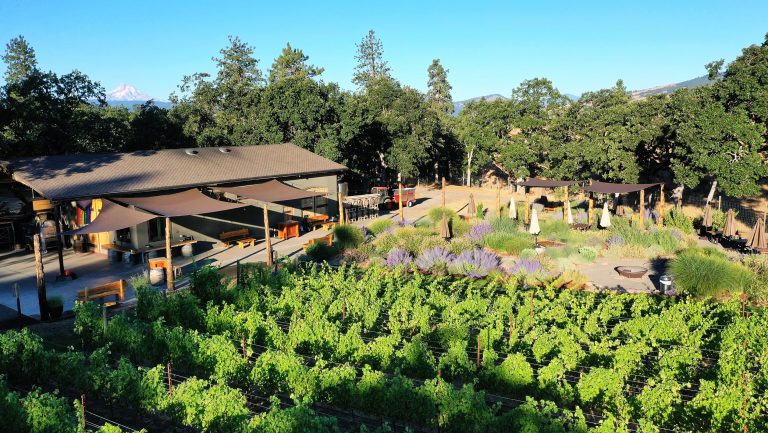When Tom Barse and Carolann McConaughy bought Stillpoint Farm in Mount Airy, Maryland, in 2008, they had one goal in mind. They wanted to prove that farmers could make a decent living if they sold a value-added product from the farm. Since they were growing wheat and hops, and Barse had been homebrewing since 1972, there wasn’t much to discuss. Milkhouse Brewery was born.
Maryland State law allowed farmers growing grapes to make wine on premises, but there was nothing on the books pertaining to beer. “So I went to the county and said I wanted to do what the local wineries did,” Barse says. “I was growing hops and other ingredients, and I wanted to open a brewery on the farm.” The county administrator, however, told him that he couldn’t do that with beer.
Barse wouldn’t take no for an answer. This is when being a retired lawyer came in handy. He set to work writing the law, which would eventually pass in 2012, that created the framework for Milkhouse to become Maryland’s first farm brewery.

Don’t miss the latest drinks industry news and insights. Sign up for our award-winning newsletters and get insider intel, resources, and trends delivered to your inbox every week.
Maryland is one of the only states to have a farm-brewing law, and it’s a pretty liberal one. There is no requirement for the amount of farm-grown ingredients that need to go into each batch, but something grown on the farm must be in each bottle.
Navigating local zoning can be one of the trickiest parts of starting a farm-based brewery. Sometimes laws conflict with one another. Barse says one Maryland county had a zoning amendment that stated that if you wanted to brew, make wine, or distill on your farm, you needed to have a commercial liquor license. That same county forbade commercial liquor licenses if your property was zoned for agricultural use.
New York enacted its farm-brewing law around the same time as Maryland. And it’s much more strict, with a specific set of targets that farm breweries must meet over time. Until the end of 2018, at least 20 percent of the hops plus 20 percent of all other ingredients that go into a farm brewery’s brews must be grown in New York State. That number increases to 60 percent in 2019, and 90 percent in 2024. Those are pretty stiff targets, especially since about 75 percent of barley grown for malting in the U.S. comes from Idaho, Minnesota, Montana, North Dakota, and Washington.
Marika Josephson, co-owner of Scratch Brewing Company, a farm brewery in southeastern Illinois, is working with the Illinois Craft Brewers Guild to get a similar law passed. She and her partner, Aaron Kleidon, employ two farmers to grow brewing ingredients like hops, fennel, ginger, tomatoes, and herbs; they also forage in the woods for mushrooms and tree bark. She says the potential benefits of legal designation for Illinois farm breweries will depend on how the law is ultimately written, but she points to New York as a role model—even with its rigorous targets.
“It’s spurred a whole new industry where there wasn’t one before,” Josephson says. “Before the law, there was no malting barley being grown in New York State, even though there had been in the past. It encouraged people to plant it because breweries would buy it, and it encouraged people to create micromalting facilities. New York has truly created a regionally grown product because of that law.” Josephson would like to see malting barley and hop production jump-started in her area.
Indeed, brewers tend to agree that increased availability of local malt is a key consideration. At Humboldt Regeneration Brewery & Farm in McKinleyville, California, Jacob Pressey calls himself a beer farmer. He brewed at Eel River Brewing Company while studying agriculture and environmental science at Humboldt State University, in Arcata. For Pressey, it’s all about sustainability. “I was thinking about carbon footprints and distribution and wondering why there aren’t local breweries still using local ingredients like estate wineries are,” he says. “I came to the conclusion that malting is the missing link because it was scaled up like most of the agricultural industry.” While more and more hop yards are popping up, and adjuncts are pretty easy to come by locally, malt has essentially become a commodity. Encouraging small-scale farmers to grow barley is one part of the equation. The other is bringing back local malt houses.

Not only does Pressey grow many of the ingredients he brews with, but he’s malting some of his grain as well. A self-taught maltster, he’s focusing on specialty malts for the greatest flavor impact. In 2015 he made his first 100 percent estate-grown malted beer, called Strange As Hell Golden Ale. His operation is small—Pressey brews on a one-barrel system—but his taproom typically has 30 taps flowing with beers made primarily from California-grown ingredients. His goal is to make people think about where beer actually comes from. “The agriculture part of beer,” he says, “isn’t advertised that much, except for hops.”
Pressey’s brewery isn’t currently on his farmland, but his goal is to buy 40 acres and scale up to a five-barrel system. There’s no farm brewery law in California, but he’s not worried. The state has an “estate model” that allows an on-site business as long as 70 percent of the land is used for agriculture.
The Brewers Association has observed a rise in the number of farm breweries being established in recent years. Chief economist Bart Watson says this business model can be a differentiator in an era of increased competition in the craft beer space, and beer consumers appear to be enthusiastic about the growing trend.
John Niedermaier owns Brewery Terra Firma in Traverse City, Michigan. A veteran brewer with more than 20 years of experience under his belt, he finally took the plunge and opened his own brewery in 2013. He calls himself an extreme brewer, which he’s quick to say doesn’t mean as much now as it did when he started out. Niedermaier has been using his brew kettle like a soup pot since he started, brewing beers with herbs, fruits, and vegetables, so it was only natural that when he finally went out on his own, he chose to build his brewery on a 10-acre farm. He has 50 beehives, two hop yards, and grows pumpkins, herbs, berries, and other fruit. He says his business has grown faster than he ever imagined. He had been planning to start distributing his products statewide within four years, but high demand enabled him to start selling his beer across Michigan in just two. “The agritourism business is huge,” Niedermaier says. “It’s another reason why customers really get behind what we do.”

Scratch Brewing Company’s Josephson agrees. While she loves that her brewery is located on a farm and she can get inspiration from what’s growing outside its doors, she adds that the farm is what draws customers in. “People are really interested in beer that’s more than just something coming out of a bottle that they get in a liquor store somewhere. They want to go to a place and see it, smell it, touch it,” Josephson says. “That’s the kind of brewery that a farm brewery is inherently. You walk through the hops [and] through rows of things that are in the beer that you’re drinking. There’s more and more interest in that.”
Has Milkhouse Brewery’s Barse proved what he set out to do? “The farm brewery saved my farm,” he says. “I’ve been in the black since day one.” His main advice to brewers who want to start a farm brewery is to get a soil test before buying property—and start raising money early, as it costs $10,000 an acre to build a hop yard.
Josephson adds that it takes a lot of perseverance and foresight to get a farm brewery up and running. “It’s really easy to feel overwhelmed and underfunded, and to get discouraged [at first],” she says. “But I think if American beer is going to have its own signature and flavors, it’s going to come out of the ground where people are brewing and farming. I don’t think there’s anything more important for brewers than to be more connected with what’s being farmed and what’s being put into their beer.”

Dispatch
Sign up for our award-winning newsletter
Don’t miss the latest drinks industry news and insights—delivered to your inbox every week.
Carolyn Malcoun is a food editor, recipe developer, and craft beer nerd. She came to Vermont to attend the New England Culinary School and fell in love with the state. She lives outside Burlington, where she’s a wannabe homesteader, hiker, and cyclist and aspires to pass the Beer Judge Certification Program.








